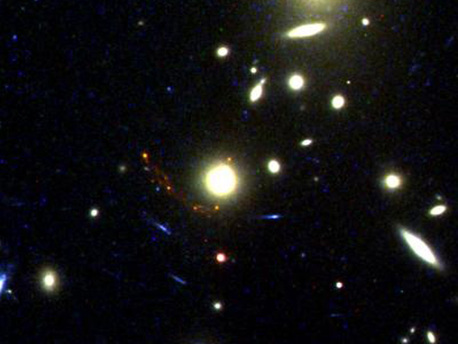Infant Galaxies
Rapid star formation spotted
 © Dr Johan Richard, Durham University
|
This is a Hubble Space Telescope observation showing the red 'arc' of the rapid star forming galaxy MS1358arc - seen as it was 12.5 billion years ago. The galaxy is magnified by a factor of 10 by the younger foreground galaxies.
Within the star-forming regions, new stars were being created at a rate of about 50 stars per year - around 100 times faster than had been previously thought. The researchers, who say their work represents the most detailed study of a galaxy at such a young age, believe the observed galaxy is typical of others in the early Universe.
The galaxy, which measures 6,000 light years across, also has all the characteristics that would allow it to eventually evolve into a galaxy such as our Milky Way, giving an insight into how our sun and galaxy formed.
"Given the size of the star forming regions, we would expect it to be forming stars at the rate of about one sun per year, but it seems to be much more active than that. We think this galaxy is fairly typical of galaxies at this time and we expect that the Milky Way once looked like this as it formed its first stars. In effect we are seeing the first generation of stars being born in a galaxy like the Milky Way. This gives unique insight into the birth of our own galaxy."
The researchers say most of the observed stars eventually exploded as supernovae, spewing debris back into space where it formed into new stars. Dr Swinbank added: "In this respect these stars are the seeds of future star formation in the Universe."
The ground breaking research gives great insight into how our own galaxy might have looked like when it was very young.
Source: Durham University
Infant Galaxies
Rapid star formation spotted
 © Dr Johan Richard, Durham University
|
This is a Hubble Space Telescope observation showing the red 'arc' of the rapid star forming galaxy MS1358arc - seen as it was 12.5 billion years ago. The galaxy is magnified by a factor of 10 by the younger foreground galaxies.
Within the star-forming regions, new stars were being created at a rate of about 50 stars per year - around 100 times faster than had been previously thought. The researchers, who say their work represents the most detailed study of a galaxy at such a young age, believe the observed galaxy is typical of others in the early Universe.
The galaxy, which measures 6,000 light years across, also has all the characteristics that would allow it to eventually evolve into a galaxy such as our Milky Way, giving an insight into how our sun and galaxy formed.
"Given the size of the star forming regions, we would expect it to be forming stars at the rate of about one sun per year, but it seems to be much more active than that. We think this galaxy is fairly typical of galaxies at this time and we expect that the Milky Way once looked like this as it formed its first stars. In effect we are seeing the first generation of stars being born in a galaxy like the Milky Way. This gives unique insight into the birth of our own galaxy."
The researchers say most of the observed stars eventually exploded as supernovae, spewing debris back into space where it formed into new stars. Dr Swinbank added: "In this respect these stars are the seeds of future star formation in the Universe."
The ground breaking research gives great insight into how our own galaxy might have looked like when it was very young.
Source: Durham University






